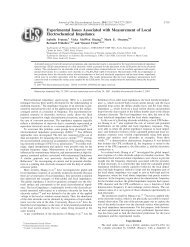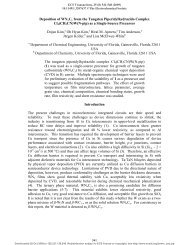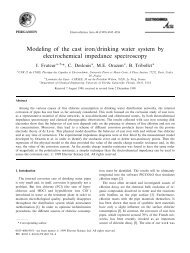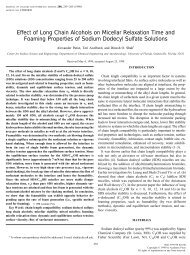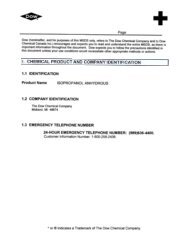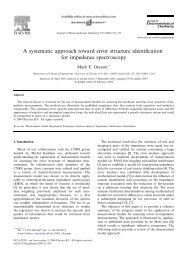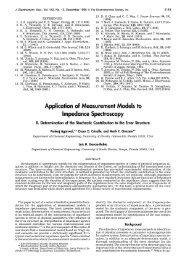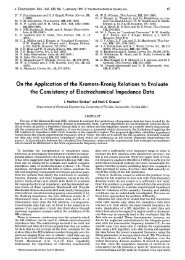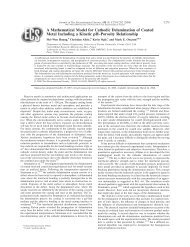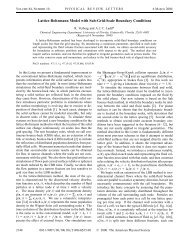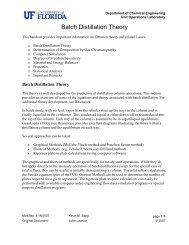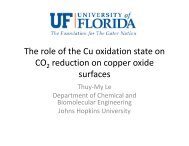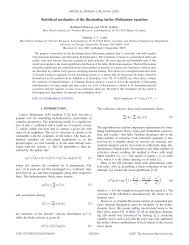Effect of Degree, Type, and Position of Unsaturation ... - ResearchGate
Effect of Degree, Type, and Position of Unsaturation ... - ResearchGate
Effect of Degree, Type, and Position of Unsaturation ... - ResearchGate
You also want an ePaper? Increase the reach of your titles
YUMPU automatically turns print PDFs into web optimized ePapers that Google loves.
EFFECT OF UNSATURATION ON pK a OF FATTY ACIDS 205FIG. 5. pK a values vs degree <strong>and</strong> nature <strong>of</strong> unsaturation <strong>of</strong> C 18 fatty acids, obtained by acid–base titration at 20 ◦ C.FIG. 6. Schematic representation <strong>of</strong> C 18 fatty acid monolayers at the air/water interface. Note the effect <strong>of</strong> the degree <strong>of</strong> unsaturation on the area per molecule<strong>and</strong> the intermolecular distance, D, in the spread monolayers.
206 KANICKY AND SHAHTABLE 1Selected Physical Properties <strong>of</strong> C 18 Fatty AcidsC 18 fatty Structure <strong>and</strong> degree Melting point Limiting area <strong>of</strong> Intermolecular distance Observedacid <strong>of</strong> saturation temp. ( ◦ C) a monolayer (A ❛ 2 ) (A ❛ ) in monolayer b pK aStearic acid 18:0 69–71 20 c 4.47 10.15Elaidic acid 18:1; (trans)9 44–45 31–33 d 5.57–5.74 9.95Oleic acid 18:1; (cis)9 13–14 41 e 6.40 9.85Linoleic acid 18:2; (cis)9,12 −5 – −1 48 f 6.93 9.24α-Linolenic acid 18:3; (cis)9,12,15 −11 – −10 — — 8.28a Sigma–Aldrich catalog.b Calculated from limiting area <strong>of</strong> monolayer data.c Refs. 27 <strong>and</strong> 28.d Ref. 27.e Refs. 18 <strong>and</strong> 28.f Refs. 28 <strong>and</strong> 29.its trans double bond, packs much closer than its cis doublebond counterpart oleic acid. As can be seen in Fig. 5, this resultsin a higher pK a value as well. One must keep in mind thatthese molecules are always in a state <strong>of</strong> thermal kinetic motion.Even in a spread monolayer, fatty acid tails are spinning, rotating,<strong>and</strong> colliding with the adjacent molecules. These collisionsresult in increased intermolecular distance, D, as illustrated inFig. 6.Table 1 contains data on melting point temperatures (T m ),intermolecular distances between molecules in a spread monolayer,<strong>and</strong> the observed pK a values <strong>of</strong> the fatty acids studied.It is interesting to note that the decrease in pK a values correspondsto a decrease in melting point temperatures. This makessense since the melting point temperature is an indication <strong>of</strong> theenergy required to disrupt the molecular packing <strong>of</strong> crystals inthe solid phase. For molecules that can pack very closely (e.g.,stearic acid), T m is relatively high. As degree <strong>of</strong> unsaturationincreases, T m decreases <strong>and</strong> so too does pK a . However, meltingpoint temperature <strong>and</strong> pK a do not have such a strong correlation.For example, there is an approximate 30 ◦ C difference in T mbetween elaidic acid <strong>and</strong> oleic acid, while only a 0.1 differenceexists between their pK a ’s.Area/molecule <strong>and</strong> intermolecular distance calculations <strong>of</strong>fatty acid monolayers made from π-area curves leave uncertaintiesas to whether or not the fatty acids present at the surfaceare actually present in uniform spread molocules or if they haveformed aggregates or isl<strong>and</strong>s at the surface. Fatty acid monolayerphase transitions can also be studied using methods suchas X-ray diffraction (31–36), FT–Raman spectroscopy (35), <strong>and</strong>Brewster angle microscopy (BAM) (36, 37). A correlation betweenfatty acid monolayer phase transition <strong>and</strong> solution pHhas been shown using the BAM technique (37). Specifically,spread monolayers <strong>of</strong> fatty acids show maximum resistance tophase transition under compression when the pH <strong>of</strong> the solutionequals the pK a , indicating that the L 2 phase, which is characteristic<strong>of</strong> fatty acid monolayers, is stabilized by the ion–dipole interactionsbetween carboxylic acid <strong>and</strong> carboxylate headgroups(Fig. 10 <strong>of</strong> Ref. 37).In summary, the results presented in this paper report for thefirst time the effect <strong>of</strong> the degree <strong>of</strong> unsaturation on the pK a values<strong>of</strong> oleic, linoleic, <strong>and</strong> linolenic acids <strong>and</strong> further correlatethe pK a value <strong>of</strong> a long-chain fatty acid with the intermoleculardistance between the fatty acid molecules. The greater theintermolecular distance, the lower the pK a value <strong>of</strong> the acid.ACKNOWLEDGMENTThe authors convey their sincere thanks to the NFS Engineering ResearchCenter for Particle Science <strong>and</strong> Technology at the University <strong>of</strong> Florida (GrantEEC 94-02989) for partial support <strong>of</strong> this research.REFERENCES1. Shiao, S. Y., Chhabra, V., Patist, A., Free, M. L., Huibers, P. D. T., Gregory,A., Patel, S., <strong>and</strong> Shah, D. O., Adv. Colloid Interface Sci. 74, 1 (1998).2. Davies, J. T., <strong>and</strong> Rideal, E. K., “Interfacial Phenomena,” 2nd ed. AcademicPress, New York, 1963.3. Shiao, S. Y., Patist, A., Free, M. L., Chhabra, V., Huibers, P. D. T.,Gregory, A., Patel, S., <strong>and</strong> Shah, D. O., Colloids Surf. A 128, 197 (1997).4. Shah, D. O., <strong>and</strong> Schulman, J. H., J. Lipid Res. 6, 341 (1965).5. Shah, D. O., <strong>and</strong> Schulman, J. H., J. Lipid Res. 8, 215 (1967).6. Shah , D. O., <strong>and</strong> Schulman, J. H., J. Colloid Interface Sci. 25, 107 (1967).7. Singh, C. P., <strong>and</strong> Shah, D. O. , Colloids Surf. A 77, 219 (1993).8. Schneider, V. L., Holman, R. T., <strong>and</strong> Burr, G. O., J. Phys. Colloid Chem.53, 1016 (1949).9. van Deenen, L. L. M., Houtsmuller, U. M. T., de Haas, G. H., <strong>and</strong> Mulder,E., J. Pharm. Pharmacol. 14, 429 (1962).10. Langmuir, J. Am. Chem. Soc. 39, 1848 (1917).11. Heikkila, R. E., Kwong, C. N., <strong>and</strong> Cornell, D. G., J. Lipid Res. 11, 190(1970).12. Seelig, A., <strong>and</strong> Seelig, J., Biochemistry 16, 45 (1977).13. Rao, Y. K., <strong>and</strong> Shah, D. O., J. Colloid Interface Sci. 137, 25 (1990).14. Fang, H., <strong>and</strong> Shah, D. O., J. Colloid Interface Sci. 205, 531 (1998).15. Adam, N. K., Proc. R. Soc. London A 99, 336 (1921).16. Adam, N. K., <strong>and</strong> Miller, J. G. F., Proc. R. Soc. London A 142, 401 (1933).17. Schulman, J. H., <strong>and</strong> Hughes, A. H., Proc. R. Soc. London A 138, 430(1932).18. Davies, J. T., <strong>and</strong> Rideal, E. K., “Interfacial Phenomena.” Academic Press,New York, 1961.19. Budavari, S. (Ed.). “Merck Index,” 12th ed. Merck Research Labs, WhitehouseStation, NJ, 1996.
EFFECT OF UNSATURATION ON pK a OF FATTY ACIDS 20720. Sutherl<strong>and</strong>, I. O., “Comprehensive Organic Chemistry: The Synthesis <strong>and</strong>Reactions <strong>of</strong> Organic Compounds,” Vol. 2. Pergamon, Elmsford, NY, 1979.21. Kanicky, J. R., Poniatowski, A. F., Mehta, N. R., <strong>and</strong> Shah, D. O., Langmuir16, 172 (2000).22. Heikkila, R. E., Deamer, D. W., <strong>and</strong> Cornwell, D. G., J. Lipid Res. 11, 195(1970).23. Peters, R. A., Proc. R. Soc. London A 133, 140 (1931).24. Christodoulou, A. P., <strong>and</strong> Rosano, H. L., Adv. Chem. Ser. 84, 210 (1968).25. Tanford, C., “The Hydrophobic <strong>Effect</strong>: Formation <strong>of</strong> Micelles <strong>and</strong> BiologicalMembranes,” 2nd ed. Wiley, New York, 1980.26. Israelachvili, J. N., <strong>and</strong> Pashley, R. M., Nature 300, 341 (1982).27. Hifeda, Y. M., <strong>and</strong> Rayfield, G. W., J. Colloid Interface Sci. 104, 209 (1985).28. Tomoaia-Cotisel, M., Zsako, J., Mocanu, A., Lupea, M., <strong>and</strong> Chifu, E.,J. Colloid Interface Sci. 117, 464 (1987).29. Peltonen, J. P. K ., <strong>and</strong> Rosenholm, J. B., Thin Solid Films 179, 543 (1989).30. Rosano, H. L., Breindel, K, Schulman, J. H., <strong>and</strong> Eydt, A. J., J. ColloidInterface Sci. 22, 58 (1966).31. Ueno, S., Miyazaki, A., Yano, J., Furukawa, Y., Suzuki, M., <strong>and</strong> Sato, K.,Chem. Phys. Lipids 107, 169 (2000).32. Peng, J. B., Foran, G. J., Barnes, G. T., <strong>and</strong> Gentle, I. R., Langmuir 13,1602 (1997).33. Peng, J. B., Barnes, G. T., Gentle, I. R., <strong>and</strong> Foran, G. J., J. Phys. Chem. B104, 5553 (2000).34. Dutta, P., Colloids Surf. A 171, 59 (2000).35. T<strong>and</strong>on, P., Forster, G., Neubert, R., <strong>and</strong> Wartewig, S., J. Mol. Struct. 524,201 (2000).36. Fainerman, V. B., Vollhardt, D., <strong>and</strong> Johann, R., Langmuir 16, 7731 (2000).37. Johann, R., Vollhardt, D., <strong>and</strong> Möhwald, H., Langmuir 17, 4569 (2001).



